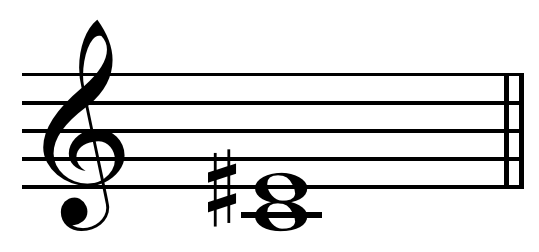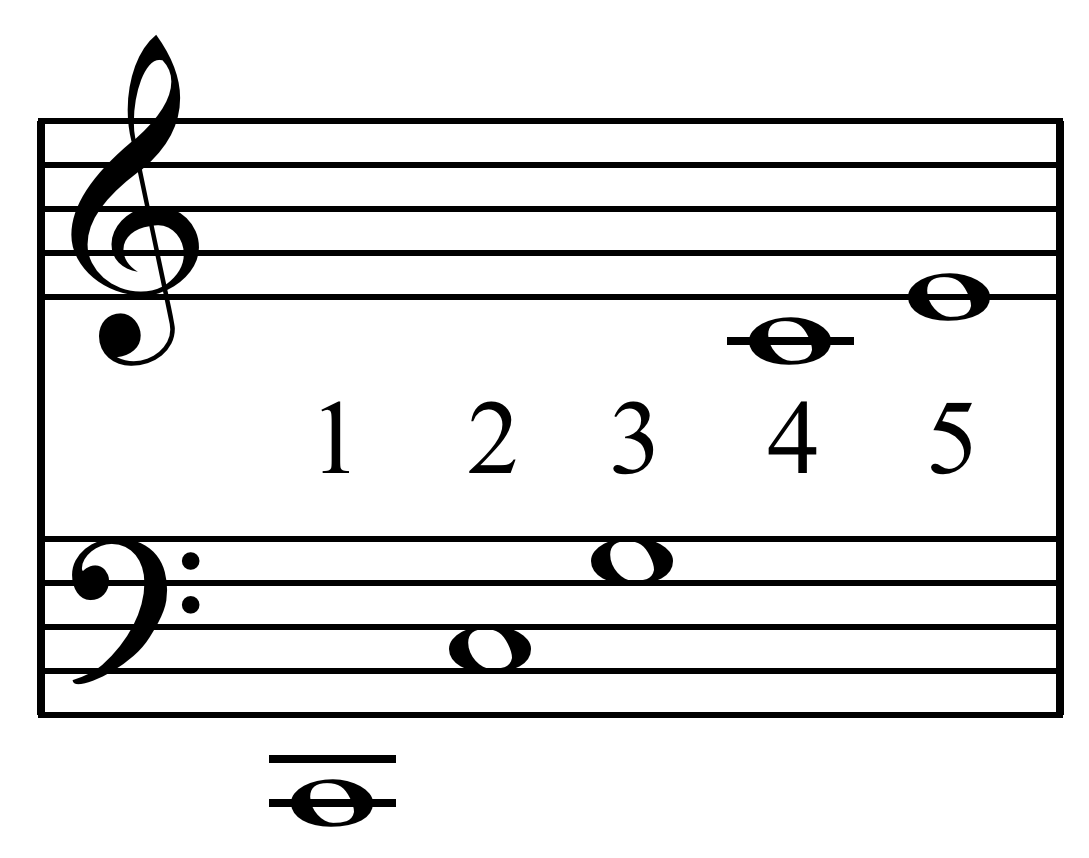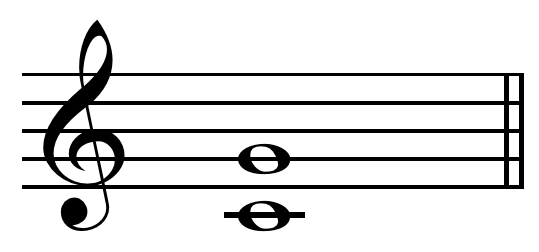|
Diminished Sixth
In classical music from Western culture, a diminished sixth () is an Interval (music), interval produced by Diminution, narrowing a minor sixth by a chromatic semitone.Benward & Saker (2003). ''Music: In Theory and Practice, Vol. I'', p.54. . Specific example of an d6 not given but general example of minor intervals described. For example, the interval from A to F is a minor sixth, eight semitones wide, and both the intervals from A to F, and from A to F are diminished sixths, spanning seven semitones. Being diminished, it is considered a consonance and dissonance, dissonant interval,Benward & Saker (2003), p.92. despite being equivalent to an interval known for its consonance. Its Inversion (interval), inversion is the augmented third, and its Enharmonic equivalency, enharmonic equivalent is the perfect fifth. "Wolf fifth" A severely Consonance and dissonance, dissonant diminished sixth is observed when a fixed-pitch instrument limited to twelve notes per octave is tuned us ... [...More Info...] [...Related Items...] OR: [Wikipedia] [Google] [Baidu] |
Augmented Third
In classical music from Western culture, an augmented third () is an interval of five semitones. It may be produced by widening a major third by a chromatic semitone.Benward & Saker (2003). ''Music: In Theory and Practice, Vol. I'', p.54. . For instance, the interval from C to E is a major third, four semitones wide, and both the intervals from C to E, and from C to E are augmented thirds, spanning five semitones. Being augmented, it is considered a dissonant interval.Benward & Saker (2003), p.92. Its inversion is the diminished sixth, and its enharmonic equivalent is the perfect fourth A fourth is a interval (music), musical interval encompassing four staff positions in the music notation of Western culture, and a perfect fourth () is the fourth spanning five semitones (half steps, or half tones). For example, the ascending int .... The just augmented third, E, is 456.99 cents or 125:96. The Pythagorean augmented third, E, is 521.51 cents or 177147:131072, eleven just p ... [...More Info...] [...Related Items...] OR: [Wikipedia] [Google] [Baidu] |
Consonance And Dissonance
In music, consonance and dissonance are categorizations of simultaneous or successive sounds. Within the Western tradition, some listeners associate consonance with sweetness, pleasantness, and acceptability, and dissonance with harshness, unpleasantness, or unacceptability, although there is broad acknowledgement that this depends also on familiarity and musical expertise. The terms form a structural dichotomy in which they define each other by mutual exclusion: a consonance is what is not dissonant, and a dissonance is what is not consonant. However, a finer consideration shows that the distinction forms a gradation, from the most consonant to the most dissonant. In casual discourse, as German composer and music theorist Paul Hindemith stressed, : "The two concepts have never been completely explained, and for a thousand years the definitions have varied". The term ''sonance'' has been proposed to encompass or refer indistinctly to the terms ''consonance'' and ''dissonance''. ... [...More Info...] [...Related Items...] OR: [Wikipedia] [Google] [Baidu] |
Perfect Octave
In music, an octave (: eighth) or perfect octave (sometimes called the Pythagorean interval, diapason) is an Interval (music), interval between two notes, one having twice the frequency of vibration of the other. The octave relationship is a natural phenomenon that has been referred to as the "basic miracle of music", the use of which is "common in most musical systems". The interval between the first and second harmonics of the Harmonic series (music), harmonic series is an octave. In Western Musical notation, music notation, notes separated by an octave (or multiple octaves) have the same Musical note#Written notes, name and are of the same pitch class. To emphasize that it is one of the interval (music)#Perfect, perfect intervals (including unison, perfect fourth, and perfect fifth), the octave is designated P8. Other Interval quality, interval qualities are also possible, though rare. The octave above or below an indicated musical note, note is sometimes abbreviated ''8a'' o ... [...More Info...] [...Related Items...] OR: [Wikipedia] [Google] [Baidu] |
Perfect Unison
Unison (stylised as UNISON) is a Great Britain, British trade union. Along with Unite the Union, Unite, Unison is one of the two largest trade unions in the United Kingdom, with over 1.2 million members who work predominantly in public services, including local government, education, health and outsourcing, outsourced services. The union was formed in 1993 when three public sector trade unions, the National Association of Local Government Officers, National and Local Government Officers Association (NALGO), the National Union of Public Employees (NUPE) and the Confederation of Health Service Employees (COHSE) merged. UNISON's current general secretary is Christina McAnea, who replaced Dave Prentis in 2021. Members and organisation Members of UNISON are typically from industries within the public sector and generally cover both full-time and part-time support and administrative staff. The majority of people joining UNISON are workers within sectors such as local government, e ... [...More Info...] [...Related Items...] OR: [Wikipedia] [Google] [Baidu] |
Just Intonation
In music, just intonation or pure intonation is a musical tuning, tuning system in which the space between notes' frequency, frequencies (called interval (music), intervals) is a natural number, whole number ratio, ratio. Intervals spaced in this way are said to be pure, and are called just intervals. Just intervals (and chords created by combining them) consist of tones from a single harmonic series (music), harmonic series of an implied fundamental frequency, fundamental. For example, in the diagram, if the notes G3 and C4 (labelled 3 and 4) are tuned as members of the harmonic series of the lowest C, their frequencies will be 3 and 4 times the fundamental frequency. The interval ratio between C4 and G3 is therefore 4:3, a just fourth (music), fourth. In Western musical practice, bowed instruments such as violins, violas, cellos, and double basses are tuned using pure fifths or fourths. In contrast, keyboard instruments are rarely tuned using only pure intervals—the desire fo ... [...More Info...] [...Related Items...] OR: [Wikipedia] [Google] [Baidu] |
Wolf Fifth
In music theory, the wolf fifth (sometimes also called Procrustean fifth, or imperfect fifth) is a particularly dissonant musical interval spanning seven semitones. Strictly, the term refers to an interval produced by a specific tuning system, widely used in the sixteenth and seventeenth centuries: the quarter-comma meantone temperament. More broadly, it is also used to refer to similar intervals (of close, but variable magnitudes) produced by other tuning systems, including Pythagorean and most meantone temperaments. When the twelve notes within the octave of a chromatic scale are tuned using the quarter-comma meantone systems of temperament, one of the twelve intervals apparently spanning seven semitones is actually a diminished sixth, which turns out to be much wider than the in-tune genuine fifths, In mean-tone systems, this interval is usually from C to A or from G to E but can be moved in either direction to favor certain groups of keys. The eleven perfect fifths s ... [...More Info...] [...Related Items...] OR: [Wikipedia] [Google] [Baidu] |
Beat (acoustics)
In acoustics, a beat is an interference pattern between two sounds of slightly different frequencies, ''perceived'' as a periodic variation in volume whose rate is the difference of the two frequencies. With tuning instruments that can produce sustained tones, beats can be readily recognized. Tuning two tones to a unison will present a peculiar effect: when the two tones are close in pitch but not identical, the difference in frequency generates the beating. The volume varies as in a tremolo as the sounds alternately interfere constructively and destructively. As the two tones gradually approach unison, the beating slows down and may become so slow as to be imperceptible. As the two tones get further apart, their beat frequency starts to approach the range of human pitch perception, the beating starts to sound like a note, and a combination tone is produced. Mathematics and physics of beat tones This phenomenon is best known in acoustics or music, though it can be found in ... [...More Info...] [...Related Items...] OR: [Wikipedia] [Google] [Baidu] |
Cent (music)
The cent is a logarithmic unit of measure used for musical intervals. Twelve-tone equal temperament divides the octave into 12 semitones of 100 cents each. Typically, cents are used to express small intervals, to check intonation, or to compare the sizes of comparable intervals in different tuning systems. For humans, a single cent is too small to be perceived between successive notes. Cents, as described by Alexander John Ellis, follow a tradition of measuring intervals by logarithms that began with Juan Caramuel y Lobkowitz in the 17th century. Ellis chose to base his measures on the hundredth part of a semitone, \sqrt 200/math>, at Robert Holford Macdowell Bosanquet's suggestion. Making extensive measurements of musical instruments from around the world, Ellis used cents to report and compare the scales employed, and further described and utilized the system in his 1875 edition of Hermann von Helmholtz's ''On the Sensations of Tone''. It has become the standard me ... [...More Info...] [...Related Items...] OR: [Wikipedia] [Google] [Baidu] |
Meantone Temperament
Meantone temperaments are musical temperaments; that is, a variety of Musical tuning#Tuning systems, tuning systems constructed, similarly to Pythagorean tuning, as a sequence of equal fifths, both rising and descending, scaled to remain within the same octave. But rather than using perfect fifths, consisting of frequency ratios of value 3:2, these are ''tempered'' by a suitable factor that narrows them to ratios that are slightly less than 3:2, in order to bring the major or minor thirds closer to Just intonation, the just intonation ratio of 5:4 or 6:5 , respectively. Among temperaments constructed as a sequence of fifths, a regular temperament is one in which all the fifths are chosen to be of the same size. Twelve-tone equal temperament () is obtained by making all semitones the same size, with each equal to one-twelfth of an octave; i.e. with ratios . Relative to Pythagorean tuning, it narrows the perfect fifths by about 2 cents (music), cents or of a Pythagorean co ... [...More Info...] [...Related Items...] OR: [Wikipedia] [Google] [Baidu] |
Pythagorean Tuning
Pythagorean tuning is a system of musical tuning in which the frequency ratios of all intervals are determined by choosing a sequence of fifthsBruce Benward and Marilyn Nadine Saker (2003). ''Music: In Theory and Practice'', seventh edition, 2 vols. (Boston: McGraw-Hill). Vol. I: p. 56. which are " pure" or perfect, with ratio 3:2. This is chosen because it is the next harmonic of a vibrating string, after the octave (which is the ratio 2:1), and hence is the next most consonant "pure" interval, and the easiest to tune by ear. As Novalis put it, "The musical proportions seem to me to be particularly correct natural proportions." Alternatively, it can be described as the tuning of the syntonic temperament in which the generator is the ratio 3:2 (i.e., the untempered perfect fifth), which is ≈ 702 cents wide. The system dates back to Ancient Mesopotamia;. (See .) It is named, and has been widely misattributed, to Ancient Greeks, notably Pythagoras (six ... [...More Info...] [...Related Items...] OR: [Wikipedia] [Google] [Baidu] |
Perfect Fifth
In music theory, a perfect fifth is the Interval (music), musical interval corresponding to a pair of pitch (music), pitches with a frequency ratio of 3:2, or very nearly so. In classical music from Western culture, a fifth is the interval from the first to the last of the first five consecutive Musical note, notes in a diatonic scale. The perfect fifth (often abbreviated P5) spans seven semitones, while the Tritone, diminished fifth spans six and the augmented fifth spans eight semitones. For example, the interval from C to G is a perfect fifth, as the note G lies seven semitones above C. The perfect fifth may be derived from the Harmonic series (music), harmonic series as the interval between the second and third harmonics. In a diatonic scale, the dominant (music), dominant note is a perfect fifth above the tonic (music), tonic note. The perfect fifth is more consonance and dissonance, consonant, or stable, than any other interval except the unison and the octave. It occu ... [...More Info...] [...Related Items...] OR: [Wikipedia] [Google] [Baidu] |
Diminished Sixth On C
Diminished may refer to: *Diminution In Western culture, Western music and music theory, diminution (from Medieval Latin ''diminutio'', alteration of Latin ''deminutio'', decrease) has four distinct meanings. Diminution may be a form of embellishment (music), embellishment in whic ... in music * "Diminished" (R.E.M. song), from the 1998 album ''Up'' *''Diminished'', a 2024 album by twlv {{disambiguation ... [...More Info...] [...Related Items...] OR: [Wikipedia] [Google] [Baidu] |






